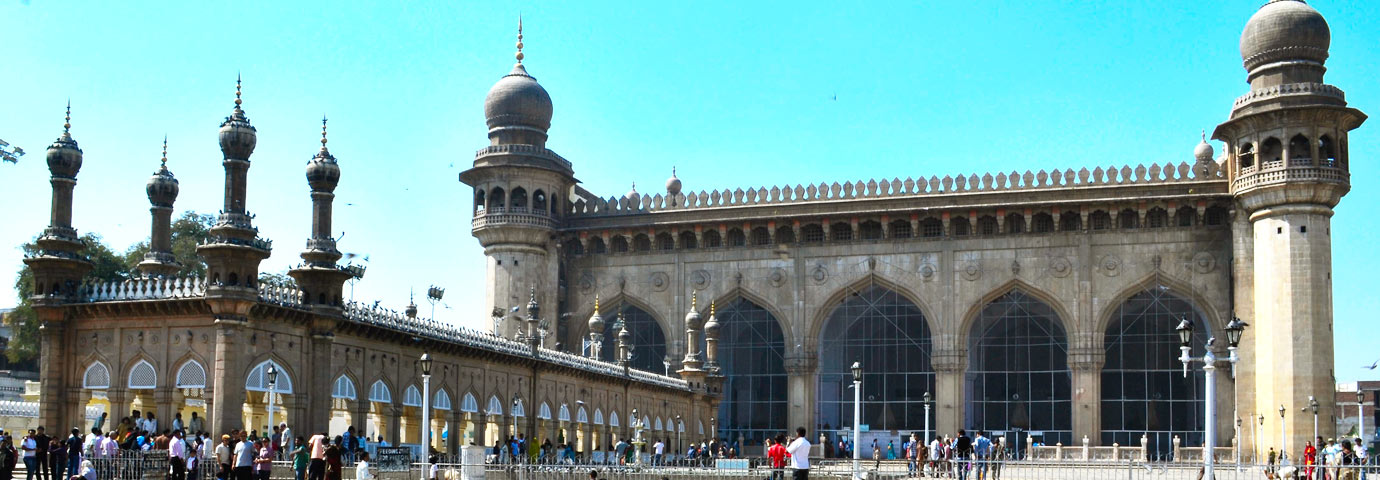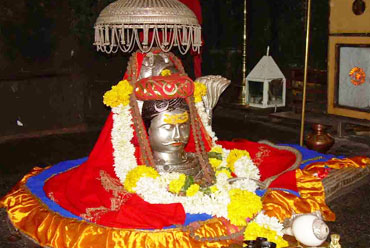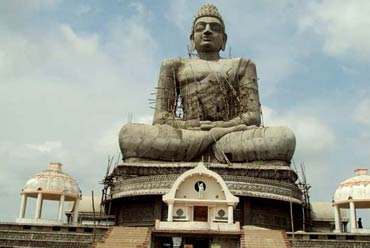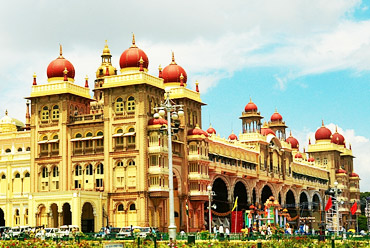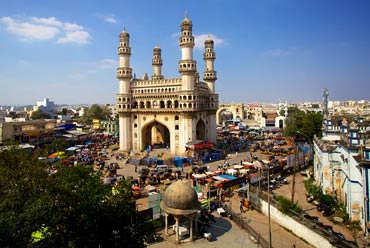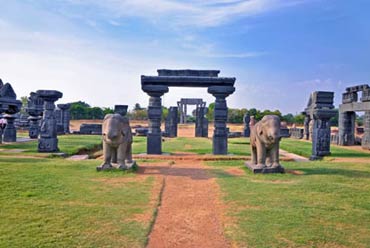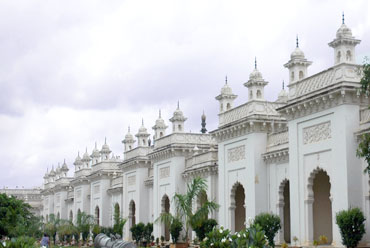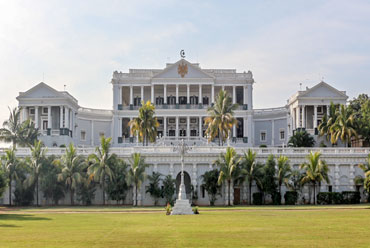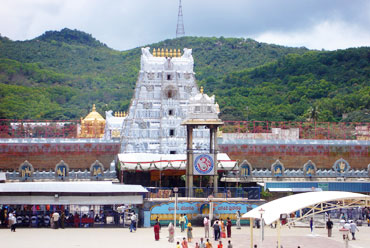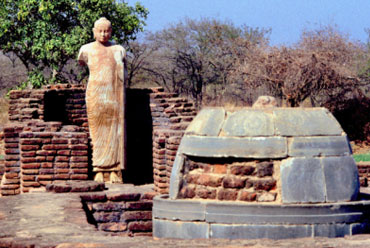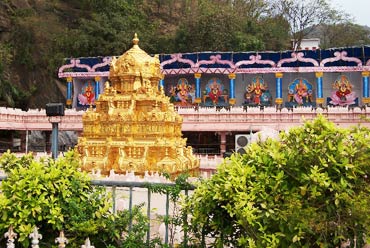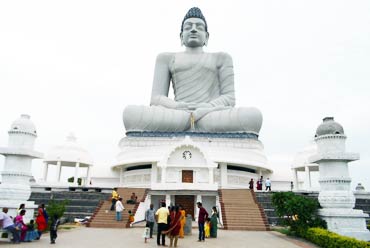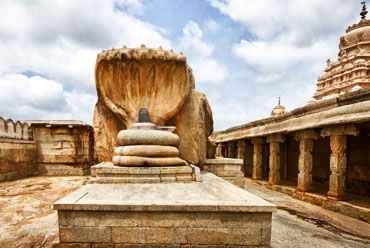Tourist Attractions in Hyderabad
The Charminar - Charminar, the hub of the city, has four wide roads radiating in the four cardinal directions. The four minarets command the landscape for miles. The structure is square, each side measuring 100 feet, with a central pointed high arch at the center. The whole edifice contains numerous small decorative arches arranged both vertically and horizontally. The prominently projected cornice on the first floor upholds a series of six arches and capitals on each façade, rising to the double-story gallery of the minarets. The projected canopy, ornamental brackets and decoration in stucco plaster add graceful elegance to the structure. On the upper courtyard, a screen of arches topped by a row of square jall or water screens lends a fragile charm to the sturdy appearance of Charminar. This courtyard was used as a school and for prayers at the mosque. The minarets, their domed finials rising from their lotus-leaves cushion, rise to 180 feet from the ground. An interesting 17th-century description of the monument comes from Thevenot: "That which is called the four towers, is a square building, of which each face is ten fathom broad and about seven high. It is opened on the four sides by four arches.
The Galleries Of Charminar - There are two galleries in it, one over another, and all over a terrace that serves for a roof, bordered with a stone balcony. At each corner of the building there is a tower about ten fathom high, and each tower has four galleries with little arches on the outside. It is vaulted underneath and appears like a dome. There is a large table raised seven or eight feet from the ground with steps to go up to it. All the galleries of that building serve to make the water mount up, that so being afterwards conveyed to the kings palace, it might reach the highest apartments. Nothing in the town seems so lovely as the outside of that building; nevertheless it is surrounded with ugly shops made of wood and covered with straw, where they sell fruit which spoils the prospect of it. The thriving market still lies around the Charminar attracting people and merchandise of every description. In its heyday, the Charminar market had some 14,000 shops, a unique conglomeration of a grand oriental bazaar. The whole market around the Charminar is crowded with shops which sell glass bangles in rainbow colors. Red, blue, green, yellow, orange, mauve and pink-or whatever shade of fancy.
The Arches Of Charminar - Near the Charminar stand four magnificent arches called Char Kaman, which served as the gateway to the Zilu Khana (ante chamber) of the royal palace and are named Machli Kaman, Kali Kaman, Sher Gil Ki Kaman and Char Minar ki Kaman. The Char-su-ka-hauz, a cistern with a fountain in the center of the arches is now called Gulzar Hauz. The royal residential palaces stood around the Charminar. Of the Qutb Shahi royal palaces in Hyderabad nothing of importance has survived; not even the Qutb Mandir, the pleasure of which admitted only Muhammad Quli and his female companions. The gardens have simply vanished. The mosques have been however spared.
The Mecca Masjid - Near the Charminar stands the Mecca Masjid, begun by Muhammad Qutb Shah in 1617 and completed by Quranzeb in 1693. It is a grand edifice with a huge courtyard which can accommodate nearly ten thousand men at prayer. Tavernier has provided a graphic description of the mammoth boulders cut to size and carted for use in the building of the mosque. The minarets look rather stunted in comparison with the grandeur of the whole massive structure. But it looks more Mughal then Qutb Shahi in its perfect granite finish and vast courtyard. A particular stone brick in the mihrab is believed to have been brought from Mecca.
Other Mosques - The other two mosques--the Jami Masjid and the Toli Masjid-are small and modest structures. Muhammad Quli Shah built the Jami Masjid in 1592, after founding Hyderabad. Musa Khan, a supervisor of works at the Mecca Masjid, levied a damri for every rupee spent on the building of the Mecca Masjid. With these collections he built the Toli Masjid, near the Purana Pul. Two buildings, the Badshahi Ashur Khana and Darul Shifa-built in 1594-are much dilapidated and in need of large scale repair.
Other Sites Of Interest - The Nizams did not build any great mosques or palaces. The last Nizam built the Falakuma palace which housed the most expensive art objects, tapestries and carpets, in addition to the largest single-man collection of diamonds. Here the Nizam had received their Majesties, the late King George V and King Edward VIII of England. The Chowmukha palace, built after the Shah palace of Teheran, is closed to visitors. The Regency Mansion, built in 1803 by James Kirkpatrick, married a Hyderabadi girl and built for her Rang Mahal, a suite of rooms in the native style.Of much interest to visitors is the Husain Sagar Lake, a large artificial lake lying between Hyderabad and Secunderaad. It was built by Ibrahim Qutb Shah around 1550, in gratitude to Husain Shah Wali, who had cured him of a disease. A tourist spot affording lovely views of the city is the Naubat Pahad, a hilltop crowned by the Birla temple. In old days royal firmans (announcements) were read to the people to the beat of drums. The Bagh-I-Aam stretches below this hillock where stands the State Legislative Assembly building. Among the newer additions to Hyderabad's grand buildings are the Osmani University, the high court and the Osmania General Hospital.
The city straddles the Musi river which, in 1908, had caused much destruction by flooding the city. Under the supervision of India's greatest engineer Sir M.Vishweshvarayya, two large reservoirs, Osman Sagar and Himayat Sagar were constructed to save the city from devastation by floods in the future. If there is some time left, a visit to the Nehru Zoological Park is recommended for a short lion safari and observing the wild beasts moving about freely in their expansive compounds. The crocodile hatchery is very informative for the young and the curious. One of the most visited places in the city is the Salar Jung museum.
Places Around Hyderabad
Golconda has been known as famous center for diamonds, and the diamond mines boast of some of the most renowned diamonds in the world. The Kohinoor originally belonged to Golconda as did the Darya-I-Noor, the Orloff, the Pitt, and the great table of the Nizam.
Warangal is situated 157 km north-east of Hyderabad. It is famous for its thousand pillar temple-a specimen of the Chalukya architecture. The fort was built by the Kakatiyas, who ruled between 12th and 14th centuries. Ruins of the mud-brick fort survive in certain portions. Kakatiyas held Golconda prior to the advent of the Qutb Shahi's and their original mud fort atop the Golconda hill was replaced with stone fortifications. The great temple at Harnamkonda was built on the slopes of the hill in 1163 by Rudra Deva. It carries some exquisitely carved pillars. The monolithic Nandi sits on guard at the entrance which also has rock cut statues of elephants on either side. The Warangal fort was conquered by Muhammad Tughlaq in the 14th century suffering much destruction. The freestanding gateway in the Buddhist tornan style is the most magnificent structure of its kind.
110 km northwest of Hyderabad lies Bidar, former capital of the Bahamani, and later on Barid Shahi dynasty. Ultimately it was annexed by Aurangzeb and subsequently the Nizams took over Bidar. It has a vast range of palaces mosques baths, schools and tombs within a strong fortified area. The tombs at Ashtur and Gawan's Madarsa have strong architectural splendor. If one has some time to spare he/she shouldn't miss nearby Gulbarga, the Bhamani capital, famous for its beautiful mosques and fort.
Nagarjunakonda, lying south-east of Hyderabad, has had been under strong Buddhist influence. The Satvahanas built a grand stupa at Amravati, embellished with most sumptuous sculptures. Later on, the Ikshvakus dominated the region around AD 235 their capital was Vijaipuri, a university town. With the decline of lkshvakus, Vijaipuri fell into neglect. The Reddy kings in the 14th century fortified the commanding hill of Nagarjunakonda, perpetuating the memory and teachings of Buddhist teacher Nagarjuna. Before work on the Nagarjunasagar Dam project began, archaeologists performed the miraculous task of transporting stone the excavated ruins of Vijaipuri to the top of Nagajunakonda hill and setting them up in their exact position. Remains of sculpture, monasteries, amphitheatre, and streets found a new safer home permanently relieved of the fear of inundation. A huge statue of Buddha dominates the crest of Nagarjunakonda. It is the old forgotten Vijaipuri of the lkshvakus which has been resurrected on the hill.

